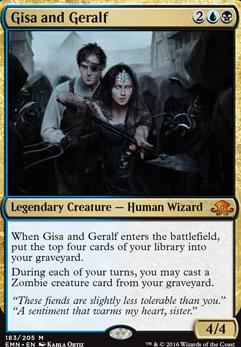The following ten parameters have been used to determine the strength of the deck. For each, a score of 5 (very good), 4 (good), 3 (mediocre), 2 (bad) or 1 (very bad) has been allocated; when totalized this score represents the power rating of the deck (maximum score is 50 points).
- Mana: indicates the availability of mana sources within the deck.
- Ramp: indicates the speed at which mana sources within the deck can be made available.
- Card Advantage: indicates availability of filter- and draw resources represented within the deck.
- Overall speed: indicates the deck’s potential for pace, based on resource availability and mana curve.
- Combo: indicates the measure of combo-orientation of the deck.
- Army: indicates the deck’s creature-army strength.
- Commander: indicates how much the deck is commander-oriented/dependent (less dependency is better).
- Interaction: indicates how much this deck can mess with opponents’ board states and turn-phases.
- Resilience: indicates whether the deck can prevent and take punches.
- Spellpower: indicates the availability and strength of high-impact spells.
Mana: 4
In all, the deck uses thirteen cards that either yield mana or cheapen casting costs. The collection is comprised of six rocks, three casting cost-reduction enablers, one mana-battery triggered by creatures dying, an instant-mana spell and two sacrifice outlets that yield mana output.
Ramp: 1
None of that in here, at least not within the mainboard. The idea of adding ramp has been toyed with, but only a few artifacts offering possibilities on this front (none of which are really in theme with the deck’s concept) have been considered.
Card Advantage: 5
Dimir involves both blue- and black magic, both excel at providing card advantage to its controller (though black often does require a sacrifice or two in exchange). For this deck, the most significant CA-area actually resides within its tutors (five cards). Draw, sometimes in exchange for a cost in life-points, is provided by six cards. One repeatable scry engine is also featured.
Overall speed: 3
In order to cast from an early stage, it is really quite dependent on its rocks and cost-reduction enablers. However, when combined with the deck’s excellent CA-options and a low average CMC, it can hit the ground running and expand fast.
Combo: 5
As mentioned in the intro, this deck’s end-game depends on combos for at least 50%. Therefore, it contains a wide range of options in this regard. A collection of cards enable possible attack strategies like infinite colorless- or colored mana, infinite zombies, infinite life-gain, infinite life-drain and infinite damage.
Army: 5
The deck’s twenty-seven creatures can be considered a cohesive force (which is impressive for a bunch of dead things) because many of them support one another’s abilities. Few of the creatures have inherently strong power- and toughness scores , but this is compensated through boosts that can be provided to all zombies (by nine of the deck’s creatures). Quite a few creatures have the capacity to expand the zombie-army through token-generation as well (currently ten of the deck’s creatures can fulfill this role).
Commander: 5
The deck’s beautiful commanders add a lot of flavor to matches and their recursion ability is amazingly fun to use. However, by no means are they necessary/required to obtain victory over opponents (none of the deck’s combos require them, the zombie-army can operate without them too). Furthermore, there’s lots of recursion back-up in here to compensate.
Interaction: 5
Let’s make life hard for opponents! Spells can be countered (five options, of which one can be repeated in the right circumstances), opposing libraries/graveyards/hands can be disrupted through forced discard, mill and exile (six options). Then there’s ways to drain life (also six options) and force opponents to sacrifice their permanents (two options). The only interaction weakness this deck truly has, is its lacking of ability to deal with opposing artifacts or enchantments.
Resilience: 4
They will not easily get rid of this deck’s creatures. No fewer than eight direct resurrection mechanics are available to its user. Then there’s also the possibility for creatures to be outfitted with undying, regenerative ability or to simply return them to hand (in all five cards have been added to enable these).
Spellpower: 1
Not that many high-impact spells to speak of. One bounce-wipe, one general forced-sacrifice, two very strong forced drains and a very powerful token multiplier.
Total power score: 38
Overall, this deck is powerful and well balanced. It features decent pace, many powerful combos and an army of zombies that can get out of hand quick. It has some issues dealing with powerful spell-slinging decks or enchantment-heavy decks that are good at restricting stuff. Fortunately, unless facing decks that are good at mass exile, they’re not going to get rid of its stuff any time soon and the multiple avenues to victory this deck offers, allows one to choose a suitable alternative for the situation one faces.





